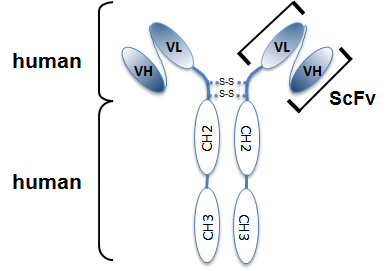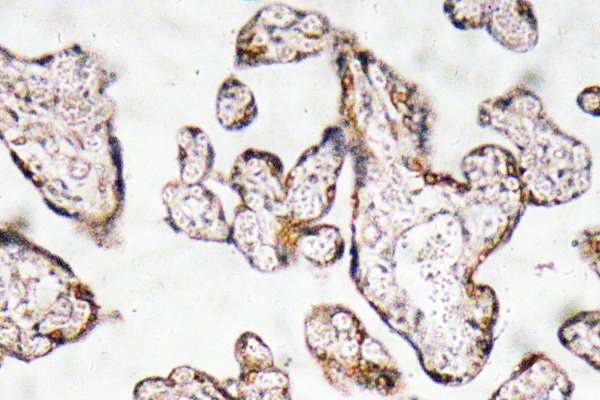
Structure of the recombinant antibody anti-PEDF (human), mAb) (rec.) (Serpy-1-4) (Prod. No. AG-27B-0014). The single chain variable human fragment (ScFv) selected by antibody phage display technology and specific to the antigen of interest is fused to a h
anti-PEDF (human), mAb (rec.) (Serpy-1-4)
AG-27B-0014
ApplicationsWestern Blot, ELISA
Product group Antibodies
ReactivityHuman
TargetSERPINF1
Overview
- SupplierAdipoGen Life Sciences
- Product Nameanti-PEDF (human), mAb (rec.) (Serpy-1-4)
- Delivery Days Customer10
- ApplicationsWestern Blot, ELISA
- CertificationResearch Use Only
- ClonalityMonoclonal
- Clone IDSerpy-1-4
- Concentration1 mg/ml
- Estimated Purity>95%
- Gene ID5176
- Target nameSERPINF1
- Target descriptionserpin family F member 1
- Target synonymsEPC-1, OI12, OI6, PEDF, PIG35, pigment epithelium-derived factor, alpha-2 antiplasmin, cell proliferation-inducing gene 35 protein, serine (or cysteine) proteinase inhibitor, clade F (alpha-2 antiplasmin, pigment epithelium derived factor), member 1, serpin peptidase inhibitor, clade F (alpha-2 antiplasmin, pigment epithelium derived factor), member 1, testis tissue sperm-binding protein Li 70n
- HostHuman
- IsotypeIgG2
- Protein IDP36955
- Protein NamePigment epithelium-derived factor
- Scientific DescriptionPigment epithelium-derived factor (PEDF) is a 47kDa secreted glycoprotein that belongs to the non-inhibitory serpin family group. PEDF is widely expressed in adult and fetal tissues, including brain, spinal cord, plasma, bone, prostate, pancreas, heart and lung. PEDF acts as an angiogenesis inhibitor with neurotrophic, immunomodulation and antitumor properties. It functions as anti-angiogenic agent by counterbalancing the proangiogenic effect of VEGF. PEDF is one of the most abundant proteins released by adipocytes and induces insulin resistance in adipocytes and human skeletal muscle cells. Recently, it has been reported that PEDF is sufficient to maintain the self-renewal of pluripotent human embryonic stem cells. Anti-PEDF (human), mAb (rec.) (Serpy-1-4) is an antibody developed by antibody phage display technology using a human naive antibody gene library. These libraries consist of scFv (single chain fragment variable) composed of VH (variable domain of the human immunoglobulin heavy chain) and VL (variable domain of the human immunoglobulin light chain) connected by a polypeptide linker. The antibody fragments are displayed on the surface of filamentous bacteriophage (M13). This scFv was selected by affinity selection on antigen in a process termed panning. Multiple rounds of panning are performed to enrich for antigen-specific scFv-phage. Monoclonal antibodies are subsequently identified by screening after each round of selection. The selected monoclonal scFv is cloned into an appropriate vector containing a Fc portion of interest and then produced in mammalian cells to generate an IgG like scFv-Fc fusion protein. - Recombinant Antibody. Recognizes human PEDF. Species cross-reactivity: Human. Clone: Serpy-1-4. Isotype: Human IgG2lambda. Applications: ELISA, WB. Host: Purified from HEK 293 cell culture supernatant. Liquid. In PBS containing 10% glycerol and 0.02% sodium azide. Pigment epithelium-derived factor (PEDF) is a 47kDa secreted glycoprotein that belongs to the non-inhibitory serpin family group. PEDF is widely expressed in adult and fetal tissues, including brain, spinal cord, plasma, bone, prostate, pancreas, heart and lung. PEDF acts as an angiogenesis inhibitor with neurotrophic, immunomodulation and antitumor properties. It functions as anti-angiogenic agent by counterbalancing the proangiogenic effect of VEGF. PEDF is one of the most abundant proteins released by adipocytes and induces insulin resistance in adipocytes and human skeletal muscle cells. Recently, it has been reported that PEDF is sufficient to maintain the self-renewal of pluripotent human embryonic stem cells. Anti-PEDF (human), mAb (rec.) (Serpy-1-4) is an antibody developed by antibody phage display technology using a human naive antibody gene library. These libraries consist of scFv (single chain fragment variable) composed of VH (variable domain of the human immunoglobulin heavy chain) and VL (variable domain of the human immunoglobulin light chain) connected by a polypeptide linker. The antibody fragments are displayed on the surface of filamentous bacteriophage (M13). This scFv was selected by affinity selection on antigen in a process termed panning. Multiple rounds of panning are performed to enrich for antigen-specific scFv-phage. Monoclonal antibodies are subsequently identified by screening after each round of selection. The selected monoclonal scFv is cloned into an appropriate vector containing a Fc portion of interest and then produced in mammalian cells to generate an IgG like scFv-Fc fusion protein.
- ReactivityHuman
- Storage Instruction-20°C,2°C to 8°C
- UNSPSC12352203




